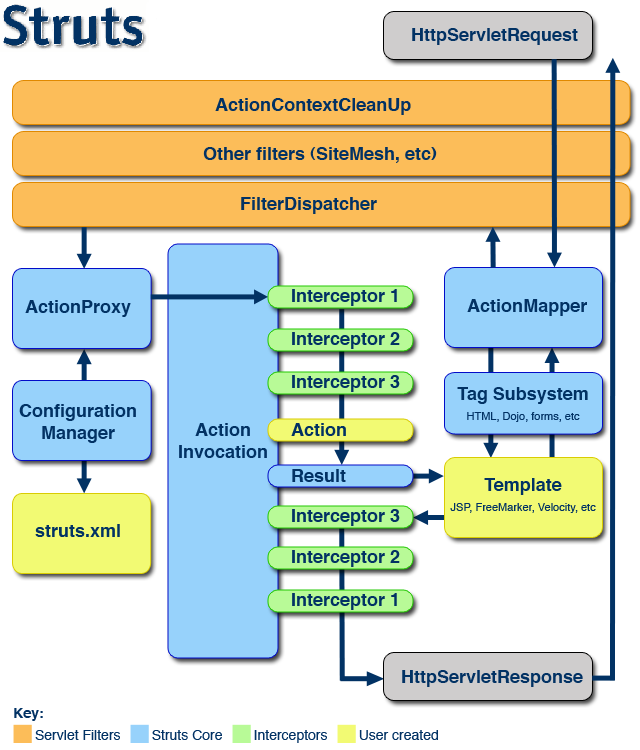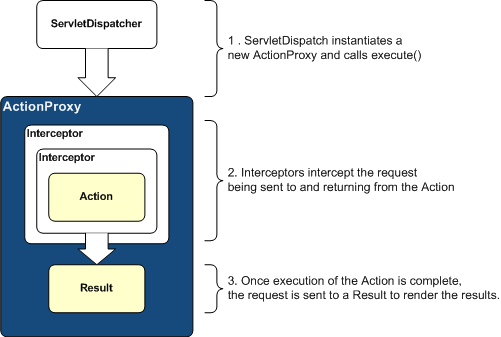一、流程图
二、源码基本流程
我们可以使用调试的方式来操作。
2.1 StrutsPrepareAndExecuteFilter的doFilter
首先我们的请求会到达 StrutsPrepareAndExecuteFilter 的 doFilter
如下:
public class StrutsPrepareAndExecuteFilter implements StrutsStatics, Filter {
.........
public void doFilter(ServletRequest req, ServletResponse res, FilterChain chain) throws IOException, ServletException {
HttpServletRequest request = (HttpServletRequest) req;
HttpServletResponse response = (HttpServletResponse) res;
try {
String uri = RequestUtils.getUri(request);
//判断是否使用struts2来处理请求,如果不是,那么放行
if (excludedPatterns != null && prepare.isUrlExcluded(request, excludedPatterns)) {
LOG.trace("Request {} is excluded from handling by Struts, passing request to other filters", uri);
//放行
chain.doFilter(request, response);
} else {
LOG.trace("Checking if {} is a static resource", uri);
boolean handled = execute.executeStaticResourceRequest(request, response);
if (!handled) {
LOG.trace("Assuming uri {} as a normal action", uri);
prepare.setEncodingAndLocale(request, response);
//创建ActionContext
prepare.createActionContext(request, response);
prepare.assignDispatcherToThread();
//包装请求
request = prepare.wrapRequest(request);
//获取到 ActionMapping
ActionMapping mapping = prepare.findActionMapping(request, response, true);
if (mapping == null) {
LOG.trace("Cannot find mapping for {}, passing to other filters", uri);
//放行
chain.doFilter(request, response);
} else {
LOG.trace("Found mapping {} for {}", mapping, uri);
//执行
execute.executeAction(request, response, mapping);
}
}
}
} finally {
prepare.cleanupRequest(request);
}
}
.........
}这里面会判断需不需要struts2来处理,如果不需要,那么放行,如果需要那么接着处理。
来到22行,创建 ActionContext。这个方法是PrepareOperations的createActionContext方法。
2.2 PrepareOperations的createActionContext
来到PrepareOperations的createActionContext方法中,如下:
/**
* Contains preparation operations for a request before execution
*/
public class PrepareOperations {
.......................
/**
* Creates the action context and initializes the thread local
*
* @param request servlet request
* @param response servlet response
*
* @return the action context
*/
public ActionContext createActionContext(HttpServletRequest request, HttpServletResponse response) {
ActionContext ctx;
Integer counter = 1;
Integer oldCounter = (Integer) request.getAttribute(CLEANUP_RECURSION_COUNTER);
if (oldCounter != null) {
counter = oldCounter + 1;
}
ActionContext oldContext = ActionContext.getContext();
if (oldContext != null) {
// detected existing context, so we are probably in a forward
ctx = new ActionContext(new HashMap<>(oldContext.getContextMap()));
} else {
//创建一个值栈
ValueStack stack = dispatcher.getContainer().getInstance(ValueStackFactory.class).createValueStack();
//把我们的请求和响应相关的域和数据添加到 值栈 的context中
stack.getContext().putAll(dispatcher.createContextMap(request, response, null));
//创建 ActionContext,其实就是 值栈的 context
ctx = new ActionContext(stack.getContext());
}
request.setAttribute(CLEANUP_RECURSION_COUNTER, counter);
ActionContext.setContext(ctx);
return ctx;
}
.......................
}29行 创建了值栈
31行 把请求相关的域以及数据添加到了值栈的context中
33行 创建ActionContext,传入的是 上面创建的值栈的context,也就是说其实 ActionContext就是值栈的contex
现在我们去看一下 31行 中的 createContextMap 方法,取到 Dispatcher 中查看 createContextMap() 方法
2.3 Dispatcher的createContextMap() 方法
createContextMap()方法其实就创建我们能够查询的 map 集合,里面它把 parameters,sessionMap,applicationMap,request,response,servletContext等数据添加到了map集合中。
/**
* A utility class the actual dispatcher delegates most of its tasks to. Each instance
* of the primary dispatcher holds an instance of this dispatcher to be shared for
* all requests.
*
* @see InitOperations
*/
public class Dispatcher {
....................................
/**
* Create a context map containing all the wrapped request objects
* 创建一个context map 包装所有的请求对象
* @param request The servlet request
* @param response The servlet response
* @param mapping The action mapping
* @return A map of context objects
*
* @since 2.3.17
*/
public Map<String,Object> createContextMap(HttpServletRequest request, HttpServletResponse response,
ActionMapping mapping) {
//---------------------下面对数据的包装处理------------------------
// request map wrapping the http request objects
Map requestMap = new RequestMap(request);
// parameters map wrapping the http parameters. ActionMapping parameters are now handled and applied separately
HttpParameters params = HttpParameters.create(request.getParameterMap()).build();
// session map wrapping the http session
Map session = new SessionMap(request);
// application map wrapping the ServletContext
Map application = new ApplicationMap(servletContext);
//创建 包装了全部数据的 map集合
Map<String,Object> extraContext = createContextMap(requestMap, params, session, application, request, response);
if (mapping != null) {
extraContext.put(ServletActionContext.ACTION_MAPPING, mapping);
}
return extraContext;
}
/**
* Merge all application and servlet attributes into a single <tt>HashMap</tt> to represent the entire
* <tt>Action</tt> context.
*
* @param requestMap a Map of all request attributes.
* @param parameters an Object of all request parameters.
* @param sessionMap a Map of all session attributes.
* @param applicationMap a Map of all servlet context attributes.
* @param request the HttpServletRequest object.
* @param response the HttpServletResponse object.
* @return a HashMap representing the <tt>Action</tt> context.
*
* @since 2.3.17
*/
public HashMap<String,Object> createContextMap(Map requestMap,
HttpParameters parameters,
Map sessionMap,
Map applicationMap,
HttpServletRequest request,
HttpServletResponse response) {
HashMap<String, Object> extraContext = new HashMap<>();
//Map结合中添加 parameters,sessionMap,applicationMap,request,response,servletContext
//等对象,后面的访问提供数据
extraContext.put(ActionContext.PARAMETERS, parameters);
extraContext.put(ActionContext.SESSION, sessionMap);
extraContext.put(ActionContext.APPLICATION, applicationMap);
extraContext.put(ActionContext.LOCALE, getLocale(request));
extraContext.put(StrutsStatics.HTTP_REQUEST, request);
extraContext.put(StrutsStatics.HTTP_RESPONSE, response);
extraContext.put(StrutsStatics.SERVLET_CONTEXT, servletContext);
//添加数据到 request/session/application 域到map中,后面可以通过 键来获取
// helpers to get access to request/session/application scope
extraContext.put("request", requestMap);
extraContext.put("session", sessionMap);
extraContext.put("application", applicationMap);
extraContext.put("parameters", parameters);
AttributeMap attrMap = new AttributeMap(extraContext);
extraContext.put("attr", attrMap);
return extraContext;
}
......................
}
看完上面的代码以后,回到 StrutsPrepareAndExecuteFilter 中的 25行
request = prepare.wrapRequest(request);这里面它放回的包装对象其实是 StrutsRequestWrapper 的对象。struts就是通过这个
来取值的,那么我们去看一下 StrutsRequestWrapper的getAttribute()方法 。
2.4 StrutsRequestWrapper的getAttribute()方法
public class StrutsRequestWrapper extends HttpServletRequestWrapper {
...............................
/**
* Gets the object, looking in the value stack if not found
* 返回对象,如果查找不到会从值栈中查找
* @param key The attribute key
*/
public Object getAttribute(String key) {
if (key == null) {
throw new NullPointerException("You must specify a key value");
}
if (disableRequestAttributeValueStackLookup || key.startsWith("javax.servlet")) {
// don't bother with the standard javax.servlet attributes, we can short-circuit this
// see WW-953 and the forums post linked in that issue for more info
return super.getAttribute(key);
}
//获取ActionContext,由上面我们可以知道 ,这其实就是 值栈的context
ActionContext ctx = ActionContext.getContext();
//调用父类的getAttribute()方法来获取对象
Object attribute = super.getAttribute(key);
if (ctx != null && attribute == null) {
boolean alreadyIn = isTrue((Boolean) ctx.get(REQUEST_WRAPPER_GET_ATTRIBUTE));
// note: we don't let # come through or else a request for
// #attr.foo or #request.foo could cause an endless loop
if (!alreadyIn && !key.contains("#")) {
try {
// If not found, then try the ValueStack
ctx.put(REQUEST_WRAPPER_GET_ATTRIBUTE, Boolean.TRUE);
//获取值栈
ValueStack stack = ctx.getValueStack();
if (stack != null) {
//去值栈中查找值,值栈有Root和context(ActionContext)两部分组成
//也就是说它会去root中查找,找不到会去 context中找
//context中包含了 parameters,sessionMap,applicationMap,request,response,servletContext等的数据
//也就说如果root中找不到,它会去这些数据中查找
attribute = stack.findValue(key);
}
} finally {
ctx.put(REQUEST_WRAPPER_GET_ATTRIBUTE, Boolean.FALSE);
}
}
}
return attribute;
}
}22行 我们可以看到,它会通过父类(ServletRequestWrapper)的 getAttribute()查找对象。
如果找到了,那么放回,如果找不到继续查找。
34行 获取到值栈
40行 从值栈中会查找对象。值栈是OGNL和struts2的结合,值栈有Root和context(ActionContext)两部分组成,
也就是说它会去root中查找,找不到会去 context中找,
context中包含了 parameters,sessionMap,applicationMap,request,response,servletContext等的数据,
也就说如果root中找不到,它会去这些数据中查找。
所以说,request.getAttribute()会去查找以下地方
原生request域
查找ValueStack的栈Root部分(其实就是请求的Action)
查找ValueStack的Context部分(其实就是ActionContext)
2.5 Dispatcher的serviceAction()方法
回到 StrutsPrepareAndExecuteFilter 中的 27行 获取到 ActionMapping,如果ActionMapping为空,那么说明不是struts2
处理的,那么放行。否则来到 35行
execute.executeAction(request, response, mapping);execute是ExecuteOperations的对象,所以来到 ExecuteOperations的execute()中查看
public class ExecuteOperations {
private Dispatcher dispatcher;
.............................
public void executeAction(HttpServletRequest request, HttpServletResponse response, ActionMapping mapping) throws ServletException {
dispatcher.serviceAction(request, response, mapping);
}
}可以看到 它里面有调用了 Dispatcher 的serviceAction 方法,如下:
public class Dispatcher {
.........................
public void serviceAction(HttpServletRequest request, HttpServletResponse response, ActionMapping mapping)
throws ServletException {
Map<String, Object> extraContext = createContextMap(request, response, mapping);
// If there was a previous value stack, then create a new copy and pass it in to be used by the new Action
//获取值栈
ValueStack stack = (ValueStack) request.getAttribute(ServletActionContext.STRUTS_VALUESTACK_KEY);
boolean nullStack = stack == null;
if (nullStack) {
ActionContext ctx = ActionContext.getContext();
if (ctx != null) {
stack = ctx.getValueStack();
}
}
if (stack != null) {
extraContext.put(ActionContext.VALUE_STACK, valueStackFactory.createValueStack(stack));
}
String timerKey = "Handling request from Dispatcher";
try {
UtilTimerStack.push(timerKey);
//获取命名空间
String namespace = mapping.getNamespace();
//获取action的名字
String name = mapping.getName();
String method = mapping.getMethod();
//创建Action的代理对象
ActionProxy proxy = getContainer().getInstance(ActionProxyFactory.class).createActionProxy(
namespace, name, method, extraContext, true, false);
request.setAttribute(ServletActionContext.STRUTS_VALUESTACK_KEY, proxy.getInvocation().getStack());
// if the ActionMapping says to go straight to a result, do it!
if (mapping.getResult() != null) {
Result result = mapping.getResult();
result.execute(proxy.getInvocation());
} else {
//执行
proxy.execute();
}
// If there was a previous value stack then set it back onto the request
if (!nullStack) {
request.setAttribute(ServletActionContext.STRUTS_VALUESTACK_KEY, stack);
}
} catch (ConfigurationException e) {
logConfigurationException(request, e);
sendError(request, response, HttpServletResponse.SC_NOT_FOUND, e);
} catch (Exception e) {
e.printStackTrace();
if (handleException || devMode) {
sendError(request, response, HttpServletResponse.SC_INTERNAL_SERVER_ERROR, e);
} else {
throw new ServletException(e);
}
} finally {
UtilTimerStack.pop(timerKey);
}
}
.........................
}
这里其实最主要的就是通过传递过来得 对象,创建 action的代理 ActionProxy,然后调用 ActionProxy的execute()方法
2.6 ActionProxy的execute()方法
现在来到了 ActionProxy的execute()方法
public class StrutsActionProxy extends DefaultActionProxy {
............
public String execute() throws Exception {
ActionContext previous = ActionContext.getContext();
ActionContext.setContext(invocation.getInvocationContext());
try {
// This is for the new API:
// return RequestContextImpl.callInContext(invocation, new Callable<String>() {
// public String call() throws Exception {
// return invocation.invoke();
// }
// });
//invocation是DefaultActionProxy的实例
return invocation.invoke();
} finally {
if (cleanupContext)
ActionContext.setContext(previous);
}
}
...............
}最主要的是第14行,这里面invocation是DefaultActionProxy的实例,也就说其实调用的就是 DefaultActionProxy的invocation方法
2.7 DefaultActionProxy的invocation方法 和 ActionInvocation的invoke() 方法
DefaultActionInvocation的invoke()方法
public class DefaultActionInvocation implements ActionInvocation {
...................................
/**
* @throws ConfigurationException If no result can be found with the returned code
*/
public String invoke() throws Exception {
String profileKey = "invoke: ";
try {
UtilTimerStack.push(profileKey);
if (executed) {
throw new IllegalStateException("Action has already executed");
}
//判断是否有拦截器
if (interceptors.hasNext()) {
final InterceptorMapping interceptorMapping = interceptors.next();
String interceptorMsg = "interceptorMapping: " + interceptorMapping.getName();
UtilTimerStack.push(interceptorMsg);
try {
Interceptor interceptor = interceptorMapping.getInterceptor();
if (interceptor instanceof WithLazyParams) {
interceptor = lazyParamInjector.injectParams(interceptor, interceptorMapping.getParams(), invocationContext);
}
//调用拦截器的 intercept 方法,并且把 DefaultActionInvocation的当前实例传入进去
resultCode = interceptor.intercept(DefaultActionInvocation.this);
} finally {
UtilTimerStack.pop(interceptorMsg);
}
} else {
resultCode = invokeActionOnly();
}
// this is needed because the result will be executed, then control will return to the Interceptor, which will
// return above and flow through again
if (!executed) {
if (preResultListeners != null) {
LOG.trace("Executing PreResultListeners for result [{}]", result);
for (Object preResultListener : preResultListeners) {
PreResultListener listener = (PreResultListener) preResultListener;
String _profileKey = "preResultListener: ";
try {
UtilTimerStack.push(_profileKey);
listener.beforeResult(this, resultCode);
}
finally {
UtilTimerStack.pop(_profileKey);
}
}
}
// now execute the result, if we're supposed to
if (proxy.getExecuteResult()) {
//结果处理
executeResult();
}
executed = true;
}
return resultCode;
}
finally {
UtilTimerStack.pop(profileKey);
}
}
public String invokeActionOnly() throws Exception {
return invokeAction(getAction(), proxy.getConfig());
}
...................................
}
这里我主要关注 25行,调用拦截器的 intercept 方法,并且把 DefaultActionInvocation的当前实例传入进去。
这里的拦截器就是的顺序就是默认配置的中。见后面。第一个调用的拦截器是ExceptionMappingInterceptor,如下
public class ExceptionMappingInterceptor extends AbstractInterceptor {
........
@Override
public String intercept(ActionInvocation invocation) throws Exception {
String result;
try {
//放行
result = invocation.invoke();
} catch (Exception e) {
........
}
return result;
}
........
}这里面 又调用 invocation的invoke()方法,其实就是传递进来的 DefaultActionInvocation的实例。这样就回到DefaultActionInvocation的invoke()方法
中,获取下一个拦截器,然后重复上面的步骤。知道拦截器调用完了。调用完了,就会去执行上面代码中的 30行 resultCode = invokeActionOnly();,
这样就来到了 请求的 Action中,Action处理完毕以后,56行 调用executeResult();来处理结果,这样流程就完了。
2.8 interceptor-stack—defaultStack
<interceptor-stack name="defaultStack">
<interceptor-ref name="exception"/>
<interceptor-ref name="alias"/>
<interceptor-ref name="servletConfig"/>
<interceptor-ref name="i18n"/>
<interceptor-ref name="prepare"/>
<interceptor-ref name="chain"/>
<interceptor-ref name="scopedModelDriven"/>
<interceptor-ref name="modelDriven"/>
<interceptor-ref name="fileUpload"/>
<interceptor-ref name="checkbox"/>
<interceptor-ref name="datetime"/>
<interceptor-ref name="multiselect"/>
<interceptor-ref name="staticParams"/>
<interceptor-ref name="actionMappingParams"/>
<interceptor-ref name="params"/>
<interceptor-ref name="conversionError"/>
<interceptor-ref name="validation">
<param name="excludeMethods">input,back,cancel,browse</param>
</interceptor-ref>
<interceptor-ref name="workflow">
<param name="excludeMethods">input,back,cancel,browse</param>
</interceptor-ref>
<interceptor-ref name="debugging"/>
</interceptor-stack>
























 5785
5785











 被折叠的 条评论
为什么被折叠?
被折叠的 条评论
为什么被折叠?








